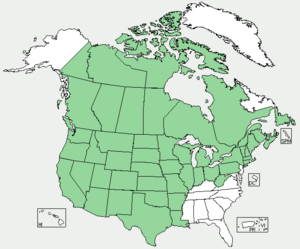Northern bog violet facts for kids
Quick facts for kids Northern bog violet |
|
|---|---|
 |
|
| Scientific classification | |
| Genus: |
Viola (plant)
|
| Species: |
nephrophylla
|
 |
|
| Distribution of Viola nephrophylla | |
| Synonyms | |
|
|
Viola nephrophylla is a beautiful wild plant. It is also known as the northern bog violet. Other names include Leconte violet or kidney leaved violet. This plant is a type of forb. A forb is a plant that is not woody. It belongs to the Violet family, called Violaceae. You can find it growing naturally across North America. It can be an annual plant, meaning it lives for one year. Or it can be a perennial, meaning it lives for many years.
Contents
About the Northern Bog Violet
The northern bog violet is a small plant. It often grows in wet, marshy areas. This is why it is called a "bog violet." It has pretty purple flowers. These flowers often bloom in the spring and summer. The plant's leaves are a special shape. They look a bit like a kidney.
How It Got Its Name
The plant Viola nephrophylla was first named in 1896. A scientist named Edward Lee Greene named it. He found specimens of the plant near Montrose, Colorado. The name nephrophylla comes from Greek words. "Nephros" means "kidney." "Phyllon" means "leaf." So, nephrophylla means "kidney-shaped leaves." This name perfectly describes the plant's unique leaves.
Where It Grows
The northern bog violet grows in many parts of North America. It can be found in different climates. This includes subarctic areas and warmer regions. It is an important part of the local plant life.
Protecting This Plant
In some places, the northern bog violet needs special care. It is listed as endangered in Massachusetts, New York, and Ohio. This means there are very few of these plants left. It is listed as threatened in New Hampshire. This means it could become endangered soon. In Connecticut, it is a special concern. This means people are watching it closely. These efforts help protect the plant. They make sure it can keep growing in the wild.
Special Uses
Native American communities have used this plant for a long time. The Ramah Navajo people, for example, used it in ceremonies. They used it as a traditional medicine. It was used to help cleanse the body. This shows how important plants are in different cultures.

